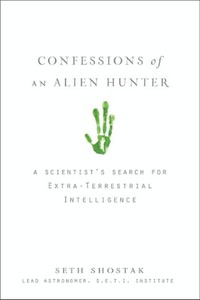Review: Confessions of an Alien Hunterby Andre Bormanis
|
| In non-technical language Shostak makes a rigorous and convincing argument that we’ve just begun to scratch the galactic surface. |
Dr. Shostak is not just a scientist, he’s a storyteller, and he tells the story of mankind’s quest to answer one of its greatest questions with both eloquence and humor. He begins by reviewing the history of scientific and religious views of the possibility that humankind is not alone. For much of that history, it was widely accepted that other worlds, including those in our own solar system, were populated by intelligent beings. During the 20th century, the growing absence of evidence to support this view led most scientists to conclude that intelligent life in yonder universe is rare, if it exists at all.
But of course absence of evidence is not evidence of absence, and Shostak goes on to explore how much we’ve learned about biology in the last few decades. Places on Earth once assumed to be utterly sterile—deep ocean trenches, arctic ice floes, boiling hot springs—have been shown to be teeming with life. If life on Earth is capable of surviving in such extreme environments, surely there must be many biologically friendly places beyond our planet. Add to this the fact that the number of known planets orbiting other stars has been growing exponentially since the first such world was revealed in the mid-1990s, and the prospects for hearing from Little Green Men (or Women) seem to be rising.
Radio telescope searches for ETs phoning our home have so far turned up nothing definitive, but as Shostak points out, we’ve barely begun looking, considering the scope of the search that would be needed to conclude that no such signals exist. In non-technical language Shostak makes a rigorous and convincing argument that we’ve just begun to scratch the galactic surface. More encouraging still, SETI technologies and search strategies are improving by leaps and bounds every year. By the end of the book I was convinced that our chances of hearing a signal from ETs in the next twenty years were better than the “slim to none” I would’ve assumed before.
Shostak sprinkles his narrative with interesting and amusing anecdotes from his years at the SETI Institute, and personal profiles of some of his esteemed colleagues. He even gives due consideration to arguments offered by UFO hunters that ET is already here. Although Shostak doesn’t accept this claim, he shows the people who make it much more respect and consideration than they typically give SETI scientists. This is a most enjoyable book, highly recommended to anyone interested in learning about how and why SETI is such a valuable, and I would say indispensable program.
